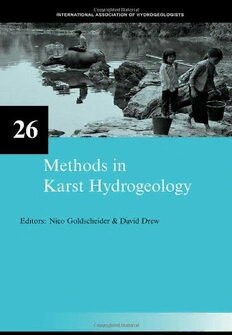Table Of ContentMETHODSINKARSTHYDROGEOLOGY
INTERNATIONALCONTRIBUTIONSTOHYDROGEOLOGY
26
SeriesEditor:Dr.NickS.Robins
Editor-in-Chief,IAHBookSeries
BritishGeologicalSurvey
Wallingford,UK
Methods in Karst
Hydrogeology
Nico Goldscheider
CentreofHydrogeology,UniversityofNeuchâtel,Switzerland
David Drew
GeographyDepartment,TrinityCollegeDublin,Ireland
LONDON / LEIDEN / NEW YORK / PHILADELPHIA / SINGAPORE
Coverphoto:RuralsceneattheLaBovillagespringinnorthwesternVietnam.Thekarstspringis
usedasadrinkingwatersourceforthepeopleandforanimals, forwashingclothes, bathing, asa
fishpondandforirrigation(photo:NicoGoldscheider,2004).
Taylor&FrancisisanimprintoftheTaylor&FrancisGroup,aninformabusiness
©2007Taylor&FrancisGroup,London,UK
This edition published in the Taylor & Francis e-Library, 2007.
“To purchase your own copy of this or any of Taylor & Francis or Routledge’s
collection of thousands of eBooks please go to www.eBookstore.tandf.co.uk.”
Allrightsreserved.Nopartofthispublicationortheinformationcontainedhereinmaybereproduced,
storedinaretrievalsystem,ortransmittedinanyformorbyanymeans,electronic,mechanical,by
photocopying,recordingorotherwise,withoutwrittenpriorpermissionfromthepublishers.
Althoughallcareistakentoensureintegrityandthequalityofthispublicationandtheinformation
herein,noresponsibilityisassumedbythepublishersnortheauthorforanydamagetotheproperty
orpersonsasaresultofoperationoruseofthispublicationand/ortheinformationcontainedherein.
Publishedby: Taylor&Francis/Balkema
P.O.Box447,2300AKLeiden,TheNetherlands
e-mail:[email protected]
www.balkema.nl,www.taylorandfrancis.co.uk,www.crcpress.com
LibraryofCongressCataloging-in-PublicationData
Methodsinkarsthydrogeology/editedbyNicoGoldscheider&DavidDrew.
p.cm.
ISBN978-0-415-42873-6(hardcover:alk.paper)1.Hydrology,Karst–Research–Methodology.
I.Goldscheider,Nico.II.Drew,David(DavidPhillip)
GB843.M482007
551.49072–dc22 2006102475
ISBN 0–203–93462–8 Master e-book ISBN
ISBN13:978-0-415-42873-6(Hbk)
ISBNe-book:978-0-20393462-3
CONTENTS
PREFACE XI
LISTOFAUTHORS XIII
1 Introduction 1
NicoGoldscheider,DavidDrew&StephenWorthington
1.1 Thepurposeofthisbook 1
1.2 Whykarstaquifersrequirespecificinvestigationtechniques 2
1.2.1 Evolutionoftheaquifer 2
1.2.2 Spatialheterogeneity 2
1.2.3 Hydraulicconductivity-scaleeffect 3
1.2.4 Dualityofrechargeandinfiltration 3
1.2.5 Dualityofporosity,flowandstorage 4
1.2.6 Temporalvariability 4
1.3 Overviewofmethodstostudykarstaquifers 4
1.4 Whatcangowrong–anexamplefromWalkerton,Canada 7
2 Thegeologicalandgeomorphologicalframework 9
NicoGoldscheider&BartoloméAndreo
2.1 Introduction 9
2.2 Mineralogy,lithologyandstratigraphy 10
2.2.1 Mineralsthatformkarstifiablerocks 10
2.2.2 Karstifiablerocks 11
2.2.3 Influenceoflithologyuponkarstifiability 12
2.2.4 Fromlithostratigraphytohydrostratigraphy 12
2.3 Geologicalstructures 14
2.3.1 Folds 14
2.3.2 Faults 15
2.3.3 Jointsandbeddingplanes 16
2.3.4 Fracturingstudies 18
2.4 Geomorphology 18
2.4.1 Classificationofkarstlandformsandgeomorphologicalmapping 18
2.4.2 Relationsbetweenkarstlandformsandhydrogeology 21
2.5 Summary 23
3 Speleologicalinvestigations 25
Pierre-YvesJeannin,ChrisGroves&PhilippHäuselmann
3.1 Introduction 25
3.2 Useofcavesurveydataforhydrogeology 28
3.2.1 Cavemapping 28
3.2.2 Cavemodellingin3-D 29
3.2.3 Precisecavepositioningandwellplacements 30
3.2.4 Interpretationofcavesurveys 32
VI Contents
3.2.5 Thepositionoftheexpectedactiveconduitsand
theircharacteristics 34
3.2.6 Cavegenesisandidentificationofphasedevelopmentincave
networks 35
3.2.7 Availabilityofcavedataforhydrogeologists 36
3.3 Investigationmethodsspecifictothecaveenvironment 36
3.3.1 Analysisofconduitmorphology 36
3.3.2 Analysisofcavesediments 37
3.3.3 Watertracingswithincaves 37
3.4 Monitoringwatersincaves 37
3.4.1 Introduction 37
3.4.2 Characterisationofflowintheinfiltrationzone 38
3.4.3 Characterisationoftransportintheinfiltrationzone 39
3.5 Summary 44
4 Hydrologicalmethods 45
ChrisGroves
4.1 Introduction 45
4.2 Generalhydrologiccharacteristicsofkarstaquifersystems 45
4.3 Abasicconcept:waterbalances 47
4.4 Springhydrographs 49
4.5 Precipitationandrechargemonitoring 50
4.5.1 Introduction 50
4.5.2 Manualgages 51
4.5.3 Automatic-recordingprecipitationgages 51
4.5.4 Dopplerradar 52
4.6 Waterflowmeasurement 52
4.6.1 Introduction 52
4.6.2 Stageheightmeasurement 53
4.6.3 Directdischargemeasurement 54
4.6.4 Currentmeters 54
4.6.5 Weirsandflumes 57
4.6.6 Tracerdilution 58
4.6.7 Non-contactmethods 60
4.6.8 Measurementofcavedrips 61
4.7 Electronicdatalogging 61
4.8 Summary 64
5 Hydraulicmethods 65
NevenKresic
5.1 Introduction 65
5.2 Hydraulicandhydrogeologicparameters 65
5.2.1 Porosity,effectiveporosityandstoragecapacity 65
5.2.2 Hydraulichead 67
5.2.3 Transmissivityandhydraulicconductivity 69
5.2.4 Groundwatervelocity 70
5.2.5 Groundwaterflow 71
5.3 Hydraulicboreholetests 75
5.3.1 Introduction 75
Contents VII
5.3.2 Packertests 75
5.3.3 Slugtests 78
5.4 Aquiferpumpingtests 80
5.4.1 Introduction 80
5.4.2 Dataanalysis 81
5.4.3 Aquiferanisotropy 89
5.4.4 Transmissivityofdiscreteaquiferzones 90
5.5 Summary 91
6 Hydrochemicalmethods 93
DanielHunkeler&JacquesMudry
6.1 Introduction 93
6.2 Parametersandprocesses 93
6.2.1 Generalities 93
6.2.2 Precipitation-relatedparameters 94
6.2.3 Soil-relatedparameters 95
6.2.4 Carbonate-rockrelatedparameters 97
6.2.5 Parametersrelatedtootherrock-types 98
6.2.6 Compoundsofanthropogenicorigin 99
6.3 Samplingstrategiesandmethods 102
6.3.1 Spatialversustemporalsampling 102
6.3.2 Samplinglocations 102
6.3.3 Samplingfrequency 103
6.3.4 Samplingmethods 103
6.4 Analyticalmethods 106
6.4.1 Methodsforcontinuousmeasurement 106
6.4.2 Laboratorymethods 106
6.5 Interpretationofhydrochemicaldata 108
6.5.1 Introduction 108
6.5.2 Assessingaquiferfunctioningusingparametersrelatedto
limestonedissolution 108
6.5.3 Assessingresidencetimeandoriginofwater 112
6.5.4 Identifyinglateralinflows 114
6.5.5 Demonstratingandquantifyingmixing 115
6.5.6 Globalanalysisusingstatisticalmethods 116
6.6 Evaluationoftheoriginandfateofcontaminants 117
6.6.1 Detectingcontaminantsatkarstsprings 117
6.6.2 Quantifyingcontaminantlevels 119
6.6.3 Identifyingcontaminantsources 120
6.6.4 Investigatingcontaminantfate 121
6.7 Summary 121
7 Isotopicmethods 123
RobertCriss,LeeDavisson,HeinzSurbeck&WilliamWinston
7.1 Introduction 123
7.2 Hydrogen,carbonandoxygenisotopes 124
7.2.1 Isotopeabundanceandsignificancetokarsthydrogeology 124
7.2.2 Isotopicvariationsandnotation 124
7.3 Oxygenandhydrogenisotopesinmeteoricwaters 126
7.3.1 Geographicvariations 126
VIII Contents
7.3.2 Temporalvariations 126
7.3.3 Meteoricwaterline 127
7.4 Sourceidentificationofkarstwater 127
7.4.1 Meteoricpercentageofkarstwaters 127
7.4.2 Isotopicmixingandsolutecorrelations 129
7.4.3 Stableisotopetracingofkarstsprings 130
7.4.4 Contributionofkarstwaterstosurfacestreams 131
7.5 Oxygenisotoperesidencetimeofkarstaquifers 132
7.5.1 Temporalisotopicvariationsinsprings 132
7.5.2 Relativemagnitudesofisotopic,physicaland
chemicalvariations 133
7.5.3 Linearreservoirmodel 133
7.5.4 Hydrologicpulsemodel 134
7.6 Radioisotopedeterminationofwaterage 136
7.6.1 Tritium 137
7.6.2 Tritium-helium-3andkrypton-85 138
7.6.3 Radiocarbontechniques 139
7.6.4 Radongastechniques 141
7.7 Summary 144
8 Tracertechniques 147
RalfBenischke,NicoGoldscheider&ChristopherSmart
8.1 Introduction 147
8.2 Typesofartificialtracers 148
8.2.1 Overview 148
8.2.2 Fluorescentdyes 148
8.2.3 Salts 151
8.2.4 Particulatetracers 152
8.3 Preparationandoperationoftracertests 153
8.3.1 Preliminaryinvestigationsandlegalaspects 153
8.3.2 Selectionofthetracertypeand
injectionquantity 153
8.3.3 Selectionoftheinjectionpointsand
injectiontechniques 155
8.3.4 Selectionofthesamplingsitesandsamplingtechniques 156
8.3.5 Laboratoryanalyses 158
8.3.6 Instrumentsforfieldmeasurement 161
8.4 Evaluationandinterpretation 162
8.4.1 Datarequirements,dataqualityanderroranalysis 162
8.4.2 Tracerbackground 163
8.4.3 Tracertransportingroundwater 164
8.4.4 Breakthroughcurves 165
8.4.5 Traveltimeandtransportvelocity 166
8.4.6 Massrecovery 166
8.4.7 Characterisationofconduitnetworks 167
8.4.8 Quantificationoftransportparametersusing
analyticalmodels 169
8.5 Summary 170
Contents IX
9 Geophysicalmethods 171
TimothyD.Bechtel,FrankP.Bosch&MarcusGurk
9.1 Introduction 171
9.2 Generalconsiderationsingeophysics 171
9.2.1 Whyusegeophysics? 171
9.2.2 Prerequisitesforsubsurfacedetection 175
9.2.3 Thenoiseproblem 176
9.2.4 Resolutionversusdepthofinvestigation 176
9.2.5 Techniqueselection 176
9.2.6 Locationcontrol 177
9.2.7 Non-uniqueness 177
9.3 Seismicmethods 177
9.3.1 Background 177
9.3.2 Seismicrefraction 179
9.3.3 Seismicreflection 180
9.3.4 Surfacewaveanalysis 181
9.4 Gravitymethods 181
9.5 Electricalandelectromagneticmethods 183
9.5.1 Background 183
9.5.2 DCelectricalmethods 183
9.5.3 ACelectromagneticmethods 185
9.5.4 Spontaneouspotential 191
9.5.5 Groundpenetratingradar(GPR) 192
9.5.6 Magneticmethods 194
9.6 Boreholegeophysicallogging 194
9.7 Summary 199
10 Modellingkarsthydrodynamics 201
AttilaKovács&MartinSauter
10.1 Introduction 201
10.2 Conceptualmodelsofkarstsystems 202
10.3 Modellingapproaches 202
10.4 Globalmodels 203
10.4.1 Introduction 203
10.4.2 Singleeventmodels(greyboxmodels) 204
10.4.3 Timeseriesanalysis 207
10.5 Distributivemodels 208
10.5.1 Introduction 208
10.5.2 DiscreteFractureNetworkApproach(DFN) 210
10.5.3 DiscreteConduitNetworkApproach(DCN) 212
10.5.4 EquivalentPorousMediumApproach(EPM) 213
10.5.5 DoubleContinuumApproach(DC) 214
10.5.6 CombinedDiscrete-Continuum(hybrid)
Approach(CDC) 216
10.6 Modellingsoluteandheattransportinkarst
aquifers 218
10.7 Summary 220

